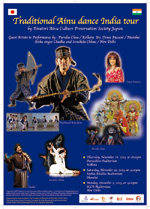 |
ミティラー美術館、および
NPO法人日印交流を盛り上げる会は 日印の文化交流に関して 様々な活動を展開しています。 |
|||
『宮内庁ホームページより転載』
ENGLISH
2013(平成25)年12月2日(火) |
日印国交樹立60周年を迎えた機会に,大統領閣下の御招待により,皇后と共に貴国を訪問できましたことを,誠に喜ばしく思います。今夕は私どものために晩餐会を催してくださり,また,ただ今は大統領閣下から丁重な歓迎の言葉を頂き,深く感謝いたします。 私は,53年前,昭和天皇の名代として,プラサド大統領の我が国御訪問に対する答訪として皇太子妃と共に初めて貴国を訪問いたしました。プラサド大統領,ラダクリシュナン副大統領,ネルー首相より手厚いおもてなしを頂き,またネルー首相により開かれたレッド・フォートにおけるデリー市民の大会を始めとして,訪れた各地において人々から温かく迎えられたことが懐かしく思い起こされます。皇后はかつて学生時代にネルー首相の「父が子に語る世界歴史」に出会っており,この旅でネルー首相と度々席を共にしたことは,今も忘れ難い思い出となっていることと思います。 貴国と我が国とは地理的に離れ,古い時代には両国の間で人々の交流はほとんどなかったように考えられます。しかし,貴国で成立した仏教は6世紀には朝鮮半島の百済から我が国に伝えられ,8世紀には奈良の都には幾つもの寺院が建立され,仏教に対する信仰は盛んになりました。8世紀には,はるばるインドから日本を訪れた僧菩提僊那が,孝謙天皇,聖武上皇,光明皇太后の見守る中で,奈良の大仏の開眼供養に開眼導師を務めたことが知られています。この時に大仏のお目を入れるために使われた筆は今なお正倉院の宝物の中に伝えられています。 古代におけるこのような例を除き,次に貴国の人々と我が国の人々との間で交流が盛んに行われるようになるのは,我が国が200年以上続けてきた鎖国政策を改め,諸外国と国交を開くことにした19世紀半ば以降のことです。第二次世界大戦前,我が国を訪れた貴国の詩人タゴールは,我が国の人々に深い敬意をもって迎えられました。私どもは先の訪問で,コルカタのタゴールハウスを訪問しましたが,タゴールが作詞作曲したインドの国歌がインドの楽器の伴奏で美しく歌われるのを聞いたことを,記憶にとどめています。 前回の貴国訪問の旅はこのコルカタ訪問に始まり,ムンバイ,デリー,アグラ,ブタガヤ,パトナ等,かなり広い地域にわたりました。私どもは二人ともまだ20代半ばの若さであり,この国の深さを十分に知るには程遠くありましたが,この旅で当時のプラサド大統領始め,独立当時からの国の指導者たちと接し,この国の来し方を学ぶとともに,この方々の民主主義,国際主義,さらには非暴力を旨としたガンジーの思想の流れをくむ平和主義を理想とする国造りへの高い志に触れたことは,今日もなお私どもの中に強い印象として刻まれています。 この度の旅行では,前回行くことのかなわなかったインド南部のチェンナイを訪れます。インドの多様性を知る上で,更なる経験を持つこの機会を楽しみにしています。 終わりになりましたが,貴国議会が年ごとの8月,我が国の原爆犠牲者に対し追悼の意を表してくださることに対し,国を代表し,とりわけ犠牲者の遺族の心を酌み,心から感謝の意を表します。 この度の私どもの訪問が,両国国民の相互理解を更に深め,信頼と友情の絆を一層強める一助となることを願いつつ,ここに大統領閣下並びに令嬢の末永い御健勝と,貴国国民の幸せを祈り,杯を挙げたいと思います。 |
|
|
The address in reply by His Majesty the Emperor of the State Banquet organised by the President of India (December 2, 2013) |
It is a great pleasure for the Empress and myself to visit your country at the invitation of Your Excellency President Pranab Mukherjee on the occasion of the 60th anniversary of diplomatic relations between Japan and India. I would like to express my profound gratitude to Your Excellency for hosting this banquet for us this evening, and for your most gracious words of welcome. I visited your country for the first time 53 years ago as a representative of Emperor Showa, with the then Crown Princess, to reciprocate the visit to Japan by His Excellency President Rajendra Prasad. We were received with the most gracious hospitality by Their Excellencies President Prasad, Vice President Sarvepalli Radhakrishnan, and Prime Minister Jawaharlal Nehru. I fondly recall the warm welcome we received from the people everywhere we went on our journey around the country, including the Delhi citizens' welcome event at Red Fort organized by Prime Minister Nehru. As a student, the Empress had encountered Glimpses of World History, a book written by Prime Minister Nehru in the form of letters addressed to his daughter Indira, and I am sure that the Empress still cherishes the memories of the various occasions in the course of our visit when Prime Minister Nehru joined us. Given the geographical distance between our two countries, it is thought that there was little interaction between Japan and India in ancient times. But by the sixth century, Buddhism, which had originated in India, was introduced to Japan via Paekche on the Korean Peninsula. By the eighth century, the city of Nara, the capital of Japan at the time, was home to many Buddhist temples, and the religion came to be widely practiced in Japan. In the eighth century, it is known that an Indian monk by the name of Bodhisena, who had traveled to Japan all the way from India, presided as the officiating priest at the eye-opening ceremony of the statue of the Great Buddha in Nara, in the presence of Empress Koken, Ex-Emperor Shomu, and Empress Dowager Komyo. The brush which was used in the ceremony to paint in the eyes of the Great Buddha is preserved to this day as a treasure at the Shosoin Repository. Other than a few ancient examples such as this, exchanges between the peoples of our two countries did not take place until after the mid-19th century, when Japan decided to end its more than 200 years of national seclusion and enter into diplomatic relations with other countries. The Indian poet Rabindranath Tagore, who visited Japan before World War II, was welcomed with deep respect by the Japanese people. On our previous tour of India, we visited the Tagore House in Kolkata. There I remember listening to the Indian national anthem, whose words and music were written by Tagore, being beautifully sung to the accompaniment of Indian musical instruments. Our previous journey to India spanned quite a wide area, beginning in Kolkata and covering Mumbai, Delhi, Agra, Bodh Gaya and Patna, among other places. The Empress and I were both very young at the time, only in our mid-twenties, and we fell far short of fully understanding the depth of your great country. But through our exchanges with then President Prasad and other leaders who had led the country since its independence, we were able to learn about India's past and become aware of these leaders' high aspirations for nation-building, based on the ideals of democracy, internationalism, and pacifism directly affiliated with Mahatma Gandhi's principle of non-violent resistance. This experience has left a strong and lasting impression on us to this day. Our tour this time includes the southern city of Chennai, which we could not visit last time. We are looking forward to this opportunity as an experience to further our understanding of India's diversity. Finally, on behalf of the people of Japan, and particularly taking into consideration the feelings of those who have lost family members in the atomic bombings, I would like to express my heartfelt gratitude to the Parliament of India for paying tribute to Japan's atomic bomb victims in August every year. It is my hope that our current visit will help to further deepen the mutual understanding between the peoples of our two countries and further strengthen our bond of trust and friendship. I would now like to raise my glass in a toast to many years of good health for Your Excellency President Mukherjee and Ms. Sharmistha and to the happiness of the people of India. |
|
|
(c) Copyright 1996/2013 Mithila Museum. All rights reserved.
 【平成アイヌ文化使節団のインド公演の詳細は
【平成アイヌ文化使節団のインド公演の詳細は